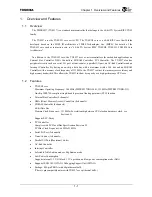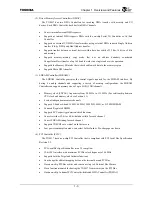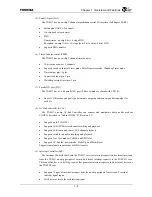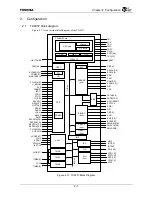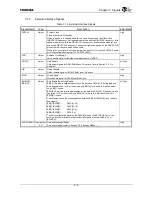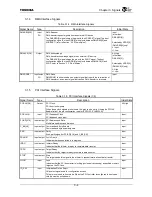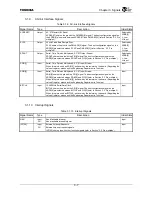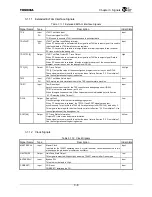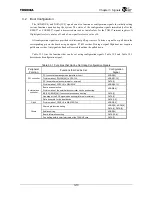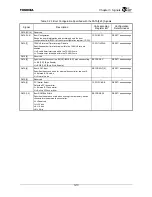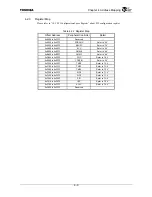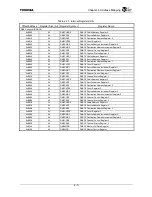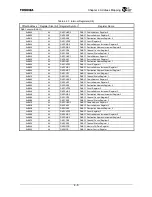
Chapter 3 Signals
3-5
Table 3.1.5 PCI Interface Signals (2/2)
Signal Name
Type
Description
Initial State
DEVSEL
*
Input/output Device Select
The target asserts this signal in response to access from the initiator.
Input
REQ[3:2]
*
Input
Request
Signals used by the master to request bus mastership. The boot configuration signal on
the DATA[2] pin determines whether the built-in PCI bus arbiter is used. In internal arbiter
mode, REQ[3:2]
*
are PCI bus request input signals. In external arbiter mode, REQ[3:2]
*
are not used. Because the pins are still placed in the input state, they must be pulled up
externally.
Input
REQ[1]
*
/INTOUT
Input/output/
OD
Request
Signal used by the master to request bus mastership. The boot configuration signal on
the DATA[2] pin determines whether the built-in PCI bus arbiter is used. In internal arbiter
mode, this signal is a PCI bus request input signal. In external arbiter mode, this signal is
an external interrupt output signal (INTOUT). Refer to Section “15.3.7 Interrupt
Requests”.
Selected by
DATA[2]
H: Input
L: Hi-Z
REQ[0]
*
Input/output
Request
Signal used by the master to request bus mastership. The boot configuration signal on
the DATA[2] pin determines whether the built-in PCI bus arbiter is used. In internal arbiter
mode, this signal is a PCI bus request input signal. In external arbiter mode, this signal is
a PCI bus request output signal.
Selected by
DATA[2]
H: Input
L: High
GNT[3:0]
*
Input/output
Grant
Indicates that bus mastership has been granted to the PCI bus master. The boot
configuration signal on the DATA[2] pin determines whether the built-in PCI bus arbiter is
used. In internal arbiter mode, all of GNT[3:0]
*
are PCI bus grant output signals. In
external arbiter mode, GNT[0]
*
is a PCI bus grant input signal. Because GNT[3:1]
*
also
become input signals, they must be pulled up externally.
Selected by
DATA[2]
H: All High
L: Input
PERR
*
Input/output
Data
Parity
Error
Indicates a data parity error in a bus cycle other than special cycles.
Input
SERR
*
Input/OD
System
Error
Indicates an address parity error, a data parity error in a special cycle, or a fatal error.
In host mode, SERR
*
is an input signal. In satellite mode, SERR
*
is an open-drain output
signal. The mode is determined by the boot configuration signal on the ADDR[19] pin.
Input
M66EN
Input/output PCI Bus 66 MHz Clock Enable
1: Enable 66 MHz operating mode.
0: Disable 66 MHz operating mode.
This pin is configured as input in satellite mode and as output in host mode. The mode is
selected through the logic level of the ADDR[19] pin at boot time. This pin must be pulled
down when the PCI Controller is configured in satellite mode and when the 66-MHz
operating mode is disabled.
Selected by
ADDR[19]
H: Low
L: Input
PME
*
Input/OD
Power Management Event
PME
*
indicates the power management mode. In host mode, PME
*
is an input signal. In
satellite mode, PME
*
is an open-drain output signal. The mode is determined by the boot
configuration signal on the ADDR[19] pin.
Selected by
ADDR[19]
H: Input
L: Hi-Z
EEPROM_DI Input
PU
EEPROM Data In
Data input from serial EEPROM for initially setting the PCI configuration.
Input
EEPROM_DO Output EEPROM
Data
Out
Data output to serial EEPROM for initially setting the PCI configuration.
Low
EEPROM_CS Output EEPROM
Chip
Select
Chip select for serial EEPROM for initially setting the PCI configuration.
Low
EEPROM_SK Output EEPROM
Serial
Clock
Clock for serial EEPROM for initially setting the PCI configuration.
Low
Note: The PCI bus specification specifies that the following pins require pullups: FRAME
*
, IRDY
*
,
TRDY
*
, STOP
*
, LOCK
*
, DEVSEL
*
, PERR
*
, SERR
*
and PME
*
. If these pins are unused, pullups
must be provided externally to the TX4937.
Summary of Contents for TX49 TMPR4937
Page 1: ...64 Bit TX System RISC TX49 Family TMPR4937 Rev 2 0 ...
Page 4: ......
Page 13: ...Table of Contents ix TMPR4937 Revision History 1 ...
Page 14: ...Table of Contents x ...
Page 15: ...Handling Precautions ...
Page 16: ......
Page 18: ...1 Using Toshiba Semiconductors Safely 1 2 ...
Page 40: ...3 General Safety Precautions and Usage Considerations 3 18 ...
Page 42: ...4 Precautions and Usage Considerations 4 2 ...
Page 43: ...TMPR4937 2005 3 Rev 2 0 ...
Page 44: ......
Page 52: ...Chapter 1 Overview and Features 1 6 ...
Page 156: ...Chapter 7 External Bus Controller 7 56 ...
Page 491: ...Chapter 16 Removed 16 1 16 Removed ...
Page 492: ...Chapter 16 Removed 16 2 ...
Page 493: ...Chapter 17 Removed 17 1 17 Removed ...
Page 494: ...Chapter 17 Removed 17 2 ...
Page 495: ...Chapter 18 Removed 18 1 18 Removed ...
Page 496: ...Chapter 18 Removed 18 2 ...
Page 497: ...Chapter 19 Removed 19 1 19 Removed ...
Page 498: ...Chapter 19 Removed 19 2 ...
Page 506: ...Chapter 20 Extended EJTAG Interface 20 8 ...
Page 530: ...Chapter 22 Pinout and Package Information 22 10 ...
Page 542: ...Chapter 24 Parts Number when Ordering 24 2 ...



